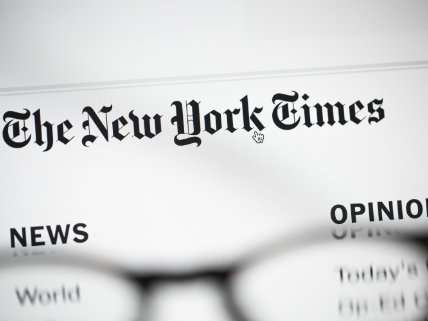The New York Times' Tax Coverage Goes Off the Rails
The Times news columns have been openly campaigning against Trump's tax cuts from the moment they were rolled out.

Binyamin Appelbaum is one of the more fair-minded and accurate reporters at The New York Times. For an example of his best work, one might look back to his reporting from Hazleton, Pa., in October of 2016. So it was particularly dismaying to read Appelbaum's dispatch over the weekend in the Times, under the headline "Trump Tax Plan Will Not Bolster Growth, Economists Say."
The Times news columns have been openly campaigning against Trump's tax cuts, from the moment they were rolled out. The paper's day one front page headline was "Tax Overhaul Would Aid Wealthiest." Its day two headline was "Trump's Plan Shifts Trillions To Wealthiest."
Even by that low standard, though, the Appelbaum story was something to behold. It's worth taking a careful look at as an example of the techniques that the press uses with the effect of distorting the debate about the tax cut.
The first ingredient is a headline that goes beyond what the story itself says. Buried in the penultimate paragraph of Appelbaum's article are two estimates of how tax cuts might bolster growth. "The Tax Foundation thinks 0.4 percent is a reasonable estimate of the best case. Mr. Holtz-Eakin said that he regarded 0.5 percent as an upper bound on the potential benefits," the story says.
It's not clear whether these estimates are of any tax cuts or of Trump's tax cuts in particular. But the Tax Foundation blog carries an article that says just a cut in the corporate tax rate to 15 percent—without the individual rate cuts Trump is also proposing—would generate "something more like 0.4 percent over the budget window: a sustained period of 2.3 percent growth instead of 1.9 percent growth, until the economy is eventually about 4 percent larger."
So the headline about "will not bolster growth" is inaccurate. The cuts would bolster growth, at least by some estimates, just not by the amount that Appelbaum has arbitrarily set up as a goalpost.
The way the Times describes these growth numbers—as decimal percentages—is itself a kind of spin. Using language like "0.4 percent" makes the growth sound small. But higher annualized growth rates compound over time. When, in other articles, the Times talks about other percent-based fees—say, those charged by money managers to public pension funds—it uses real dollar figures to make the numbers sound larger: "almost $750 million in direct investment expenses," "an additional $1.8 billion over five years and almost $8 billion after 15 years."
The U.S. annual gross domestic product is about $18 trillion, so a "4 percent larger" economy means $720 billion—or $720,000,000,000—more goods and services produced each year. That is nothing to sneeze at. At that is just the effect of a corporate tax reduction, not other growth-inducing steps such as personal income tax reductions, deregulation, increased energy exploration and production, a stable dollar, or (if you buy the idea that this is stimulative) a military buildup.
Nor are the growth numbers the only way that this Times article uses numerals in a misleading way. The newspaper is also spinning when it comes to tax rates. The article says: "there is little evidence that current rates are high enough to discourage people from earning as much money as they can. When Mr. Reagan took office, the top tax rate was 70 percent; now, it is 39.6 percent."
The Times-chosen comparison of "70 percent" and "39.6 percent" makes the current rate appear low. It would have been accurate, however, to write, "When Mr. Reagan left office, the top individual income tax rate was 28 percent; now, as the Times reported on its front page back in 2013, in California the combined top state and federal income tax rate is 51.9 percent, while in New York City it is 51.7 percent. Even for lower-income individuals, the combined effects of means-tested benefit phase-outs and marriage penalties can create all kinds of perverse incentives, as the University of Chicago economist Casey Mulligan argues in his book The Redistribution Recession."
The Times took this argument seriously in its economics blog back in 2013. Back then, it published an article under the headline "The Marginal Tax Rate Mess" that acknowledged, "As a result of losing eligibility for means-tested benefits, low-income and middle-income families sometimes experience much higher marginal effective tax rates (sometimes exceeding 90 percent) than those at the top of the income distribution."
Now that President Trump wants to reduce taxes, though, the Times doesn't even bother to mention that evidence; it just states, inaccurately, that there is "little evidence."
It's no wonder Trump rails against the "fake news" of the "failing New York Times." On the topic of taxes, Times coverage has gone off the rails.


Show Comments (31)